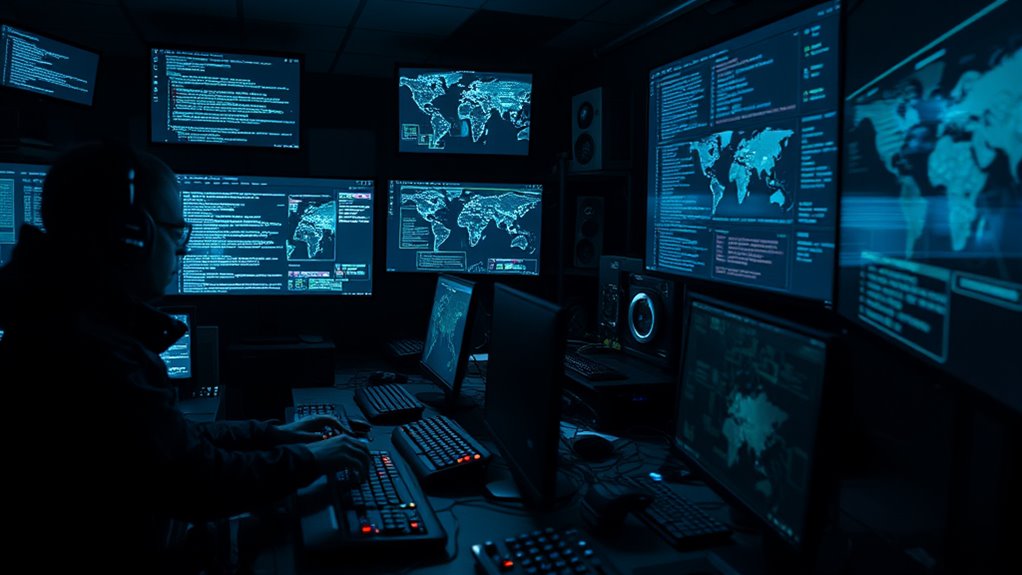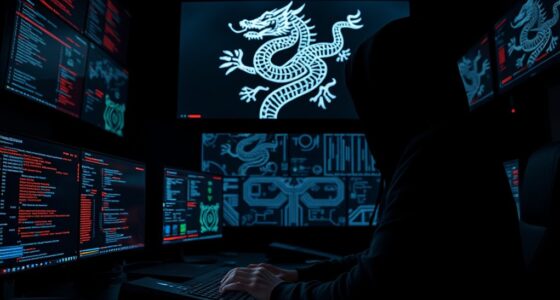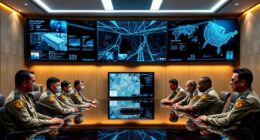The NSA’s TAO Unit is an elite team of hackers that infiltrates foreign networks to gather intelligence covertly. They use sophisticated tools like zero-day exploits and custom malware to stay ahead of defenses and avoid detection. Their operations support national security and counterterrorism, often remaining hidden behind the scenes. If you’re curious about how these covert cyber warriors operate and navigate the digital battlefield, there’s more to uncover about their strategies and impact.
Key Takeaways
- TAO is NSA’s elite hacking team specializing in covert cyber espionage against foreign targets.
- It employs zero-day exploits, custom malware, and advanced intrusion techniques for stealth operations.
- TAO conducts clandestine operations, masking tracks to avoid detection and maintain prolonged access.
- The unit continuously develops new methods to counter emerging cyber defenses and threats.
- TAO’s covert activities provide critical intelligence, shaping national security and maintaining U.S. cyber superiority.

Have you ever wondered how the NSA conducts some of its most covert operations? Behind the scenes, the agency’s TAO unit—short for Tailored Access Operations—serves as its elite hacking team. This specialized division is responsible for executing cyber espionage missions that target foreign governments, terrorist networks, and other high-value targets. When you think about clandestine operations, TAO is the embodiment, operating discreetly within the shadows of cyberspace to gather intelligence that’s essential for national security. Their work often involves penetrating sophisticated defenses, intercepting communications, and installing covert tools on target networks without detection.
TAO is the NSA’s elite hacking team executing covert cyber espionage to protect national security.
TAO’s cyber espionage efforts are highly strategic and precise. They don’t just hack randomly; instead, they carefully plan each operation to extract maximum intelligence with minimal risk of exposure. They utilize a wide arsenal of cyber weapons—zero-day exploits, custom malware, and sophisticated intrusion techniques—to breach even the most secure systems. Once inside, they can monitor communications, extract documents, and even manipulate data, all while remaining invisible to the target. This level of covert access allows the NSA to stay ahead of adversaries, providing essential insights that shape national security policies and counterterrorism efforts.
Clandestine operations like those executed by TAO are not just about hacking into systems—they’re about doing so quietly and efficiently. They often rely on stealth tactics that guarantee their presence remains undetectable for as long as possible. This might involve masking their tracks, disguising malware as legitimate traffic, or exploiting vulnerabilities that haven’t yet been discovered by the target. Because these operations are so sensitive, TAO operates under strict secrecy, making it one of the most clandestine elements within the NSA. Few outside the intelligence community are aware of their full scope, but their impact is profound, often determining the success of broader intelligence campaigns.
You should realize that the work of TAO is a constant race against time and evolving technology. As targets improve their defenses, TAO adapts, developing new methods of infiltration, surveillance, and data extraction. Their missions are complex, requiring top-tier technical skills and a deep understanding of global cyber landscapes. Whether infiltrating foreign networks or disabling cyber threats before they reach the U.S., TAO’s operations are at the forefront of national defense. Their clandestine efforts, driven by advanced cyber espionage, keep the United States one step ahead in the ongoing digital battleground. Additionally, staying current with advancements in projector technology can inform cybersecurity strategies and ensure the integrity of surveillance tools used in covert operations.
Frequently Asked Questions
How Does TAO Select Its Hackers?
You’re selected for TAO’s hacker recruitment based on your exceptional skills in cyber espionage and problem-solving. They look for individuals with a strong background in computer science, coding, and hacking techniques. You’re tested rigorously in real-world scenarios, evaluating your ability to think creatively under pressure. If you demonstrate discipline, adaptability, and a deep understanding of cyber operations, you’ll be chosen to join this elite unit.
What Are the Risks of Tao’s Operations?
Coincidences highlight the risks TAO faces—exposing cybersecurity vulnerabilities or ethical dilemmas. When operations go wrong, they risk revealing sensitive info or harming innocent parties, which could damage national security or trust. You might unknowingly trigger unintended consequences, making oversight essential. The high-stakes nature means even a small mistake could lead to major political fallout or legal issues, emphasizing why careful planning and strict ethical standards are indispensable for TAO’s success.
How Does TAO Collaborate With Other Intelligence Agencies?
You’ll find that TAO collaborates closely with other intelligence agencies through cyber espionage efforts and intelligence sharing. They exchange essential information to strengthen national security, coordinate operations, and track threats across borders. This partnership allows TAO to leverage broader resources and expertise, enhancing their ability to conduct covert cyber operations effectively. By working together, they create a unified front against cyber adversaries and safeguard critical infrastructure globally.
Are Tao’s Hacking Methods Ever Exposed Publicly?
You might think TAO’s hacking techniques are completely secret, but some have been publicly exposed through leaks or investigative reports. While the unit’s most advanced methods remain classified, lesser techniques and tools sometimes surface, revealing a glimpse into their operations. These exposures raise concerns about the potential risks of public exposure, but overall, TAO’s most sophisticated hacking methods stay hidden to protect national security interests.
What Skills Are Required to Join TAO?
To join TAO, you need strong cybersecurity certifications like CISSP or CEH, demonstrating your expertise. You should also have programming expertise in languages such as Python, C, or Java, enabling you to develop and analyze complex tools. Analytical thinking, problem-solving skills, and the ability to work under pressure are essential. Continuous learning and staying updated with the latest cyber threats are also vital for success in this elite unit.
Conclusion
As you consider the NSA’s TAO unit, imagine a shadowy eagle soaring silently above, watching every move in the digital sky. Their elite hackers are the unseen architects of national security, quietly shaping the battlefield of cyberspace. Though hidden, their impact is as vast as the horizon, reminding you that in the world of cyber warfare, the unseen often holds the greatest power. Their presence is a silent guardian, ever vigilant, ever ready.









